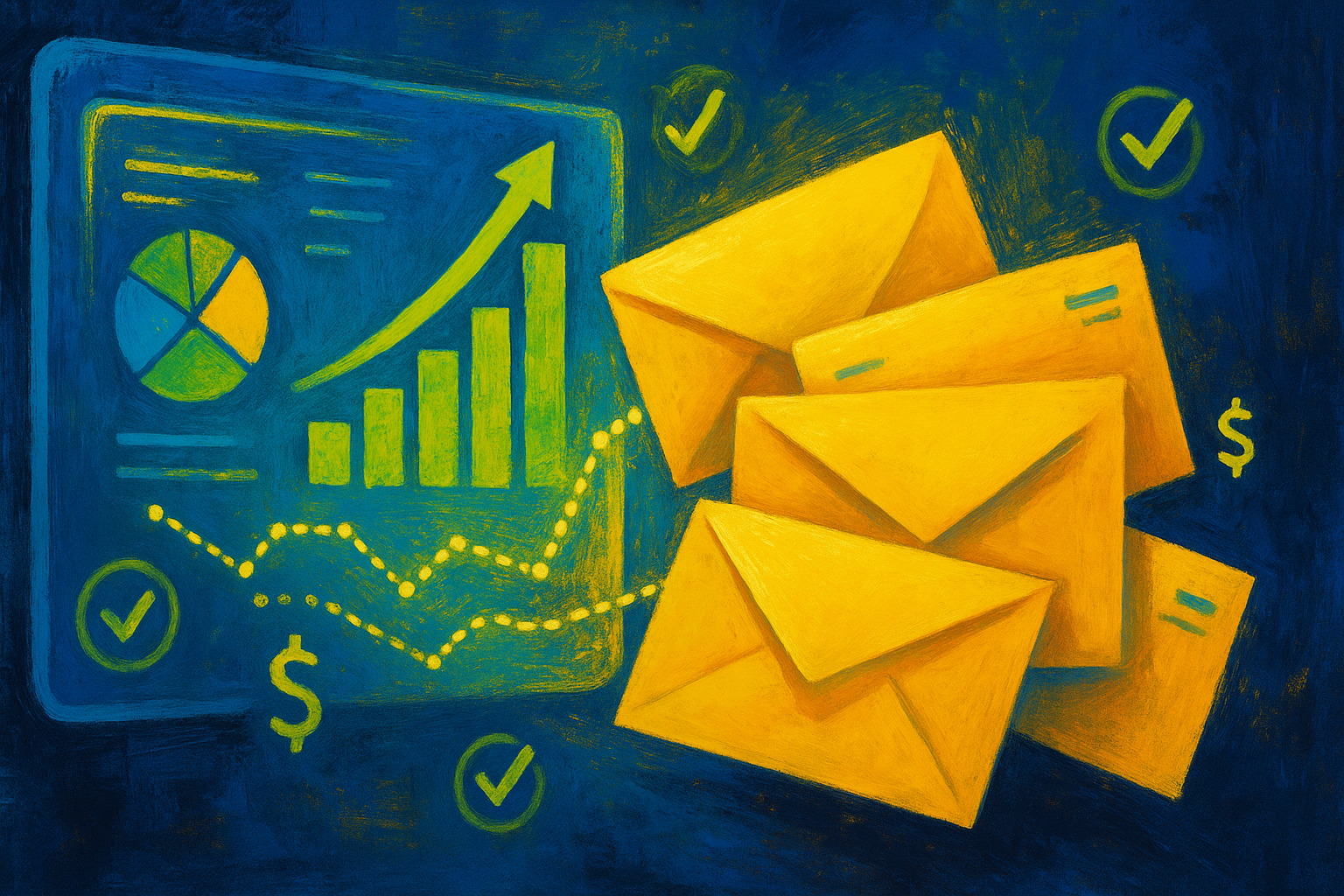How Analytics and Mailer Performance Drive Better Results
Analytics & Mailer Performance Tips for Campaign Growth
The days of sending political mail and simply hoping it works are over. Today’s winning campaigns are driven by data—using analytics and mailer performance tracking to refine outreach, boost response, and win more votes with every dollar spent. With modern tools, you can now see exactly which mailers are opened, which ones prompt action, and where your message is making the biggest impact.
Whether you’re running a city council race or a national movement, tracking mail performance helps you make smarter decisions, reach the right people, and maximize your budget. In this guide, you’ll discover how analytics reveal what works, how to measure key mailer metrics, and how to turn those insights into real-world results for your next campaign.

Why Analytics Matter for Mail Campaigns Today
Political mailers aren’t just a shot in the dark. Every piece sent is an opportunity to learn, improve, and win more support—if you know how to measure results. Analytics matter for mail campaigns because they show what works, what doesn’t, and how to do better next time. Instead of guessing which neighborhoods respond, which messages land, or when to send reminders, analytics give you hard evidence and actionable answers. For campaigns facing tight budgets, fierce competition, or tough deadlines, mailer analytics turn every postcard, letter, or brochure into a learning tool for ongoing success.
Top campaigns don’t ask, “Did people like our mail?” They ask, “What did the numbers say? Where can we do better?” That’s the power of mail analytics—data-driven improvement every step of the way.
Key Mailer Performance Metrics That Matter
Not sure what to measure when evaluating your campaign’s mailers? Here are the key mailer performance metrics every campaign should be tracking to maximize impact and improve future outreach:
Open rates can be tracked using QR codes, special barcodes, or digital tie-ins. While not all mailers offer full visibility into whether they’re opened, interactive elements help bridge that gap and give insight into how many recipients are engaging with your piece.
Response or conversion rates tell you the percentage of people who took action after receiving your mailer—whether that’s visiting your website, scanning a QR code, making a donation, or calling a campaign number. This metric is a direct measure of how effective your mailer is at motivating voter behavior.
Delivery rates help you understand how many mailers actually reached their destination. A lower delivery rate often points to outdated or inaccurate mailing lists, while consistently high rates show list health and reliability.
Bounce and return rates are crucial to track because every piece of returned mail represents wasted money and a lost opportunity. High return rates signal the need to clean up your voter or contact database for better efficiency.
Cost per response or acquisition breaks down how much you’re spending for each action your mailer generates. Whether it’s a sign-up, call, or donation, reducing this number improves your overall return on investment and campaign efficiency.
Finally, geo-targeting insights reveal which areas—neighborhoods, districts, or ZIP codes—are responding best to your outreach. Segmenting your data by location allows you to focus your future mail drops on high-performing regions and adjust strategy for underperforming ones.
Definitions (for non-experts):
Open Rate: % of mailers interacted with (QR, URL, etc.)
Response Rate: % of recipients who respond to your CTA (call, scan, visit)
Delivery Rate: % of mailers successfully delivered to the intended address
Bounce/Return Rate: % of mailers returned undelivered
Cost Per Response: Total spend divided by the number of responses
Geo-Targeting: Focusing mail based on local performance data
How to Set Up Mailer Tracking & Analytics
Setting up mailer tracking and analytics is easier than many campaigns think—and can be done at any scale. Here’s how top teams do it:
Barcoding and QR Codes:
Add unique barcodes or QR codes to each mailer. When a recipient scans the code, visits your campaign site, or calls a unique number, you track that action automatically.
Unique Phone/Text Lines:
Assign different phone numbers or SMS keywords to each mailer batch or district. Track which lines get the most calls or texts to see which mailers drive action.
Mailer Landing Pages:
Direct recipients to campaign landing pages with unique URLs. These pages log visits, sign-ups, and other engagement—connecting mail results to digital campaigns.
Integrate with CRM or Voter Database:
Sync mailer response data with your campaign’s CRM or voter file (such as NationBuilder, NGP VAN, or Salesforce). This lets you follow up, segment responders, and automate retargeting.
Top Tools and Platforms:
Mailchimp: Integrates direct mail with email and online tracking
USPS Informed Delivery: Provides delivery tracking and digital tie-ins
Ballot Scout: For ballot-related mail, tracks progress and voter interaction
Custom/Proprietary Tools: Many vendors offer white-labeled dashboards and tracking
Pro tip: Even a simple spreadsheet or Google Sheet works for smaller campaigns—what matters is consistency and attention.
Making Sense of the Data: What Analytics Reveal
Once you have the data, the real power of mail analytics comes from interpretation:
Heatmaps for Delivery and Response:
Many platforms offer visual “heatmaps” showing where your mailers get the most responses. This helps you spot high-performing neighborhoods and target your next mailing.
Segment by Audience, Timing, or Offer:
Analyze which groups (age, district, party, past turnout) respond best. See if one message or mailer version outperforms another. Was Tuesday’s drop more effective than Thursday’s?
Best Days/Times for Response:
Track which mailers land right before key voting windows or events. Analytics can reveal surprising trends—maybe weekend deliveries spark more engagement, or your absentee ballot push works best two weeks out.
Turning Mailer Insights Into Campaign Action
Great campaigns don’t just collect data—they use it. Here’s how to act on your mailer insights:
Change Messaging, Timing, or Creative:
If one message falls flat, try another. If responses lag midweek, try mailing on Friday. Use bold design changes or clearer calls to action for the next batch.
A/B Testing Mailers:
Test two (or more) versions of your mailer. Change one element—headline, image, offer—and see which version drives more responses. Analytics reveal your winner, so you can scale the most effective design.
Retargeting or Follow-Up:
Follow up with non-responders by mail, phone, or digital ads. Segment responders for thank-yous or event invites. If a mailer gets high engagement in one area, plan field canvassing there next.
Action:
Turn “numbers on a dashboard” into “actions in the field”—that’s how analytics drive better results.
Common Mistakes & How to Avoid Them
Ignoring Negative or Zero Responses:
If you only track successes, you’ll never learn from what didn’t work. Review all metrics—especially low-performing areas or messages.
Not Segmenting Your Mailer List:
Sending the same mailer to everyone is easy but wasteful. Segment by geography, age, or party for better results.
Overcomplicating Data for Small Campaigns:
Don’t get bogged down in analytics paralysis. Focus on one or two key metrics—like response rate and cost per response.
Tips:
Do track both good and bad results
Don’t send generic mail to everyone
Do use simple tools if your budget is tight
Don’t ignore compliance and privacy
Final Thoughts
Campaigns that measure, learn, and adapt consistently outperform those that don’t. Mailer analytics turn every outreach into a learning opportunity—helping you save money, target smarter, and win more support with each round. Don’t leave results to chance or guesswork.
Ready to boost your campaign’s impact?
Book a free demo of Sutton & Smart’s mailer analytics solutions and see how data-driven tracking drives real results!

Jon Sutton
An expert in management, strategy, and field organizing, Jon has been a frequent commentator in national publications.
Author | Partner





